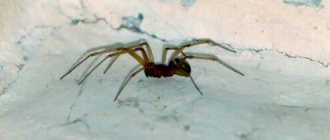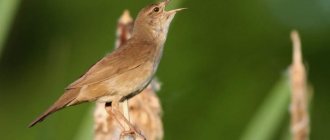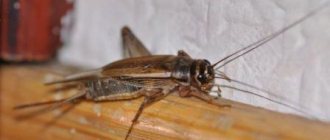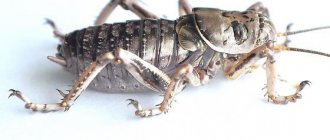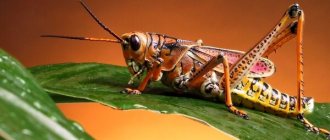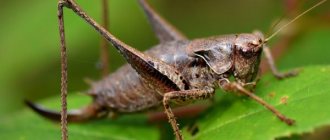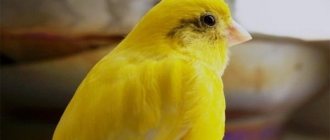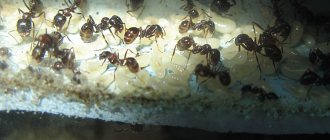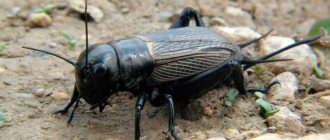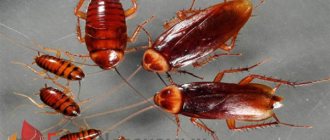- How a cricket sings
The cricket is perhaps a rare example of an exception among insects that does not cause disgust in people (such as the same
cockroaches), but on the contrary sympathy, curiosity. Since ancient times, his melodic singing has been associated with the hearth, coziness, and comfort. It’s not for nothing that the cricket is a favorite hero of many children’s fairy tales. The name of this insect comes from the Greek word for “singer”. If we resort to scientific classification, then crickets, like their relatives - grasshoppers, belong to the group of long-whiskered orthoptera insects, so named due to the possession of long mustaches and straight wings.
Description, characteristics, photo
House crickets are quite small in size; adult individuals can reach only 16 to 26 mm in length. The color of the domestic cricket is gray-yellow, also in different shades of brown, with streaks or spots of indeterminate shape.
The cricket's head is shaped like a flattened egg. Also on it (the head) there are three dark arcuate stripes. The cricket's eyes are located on the sides of the head; they have a complex facet structure. The cricket's mouth is of the gnawing type in structure. But the real pride of crickets is their large mustaches, which can sometimes be several times larger than the body of the crickets themselves. The cricket's whiskers serve a practical purpose - they are responsible for the sense of touch.
The cricket's wings are also well developed. The back pair of strong membranous wings helps them fly from place to place with ease. Crickets can also make relatively long flights. At rest, the cricket's wings are located along the abdomen; they look like sharp and long tails.
Like other orthoptera insects, the cricket has three pairs of legs. The back legs of a cricket with thickened hips are the strongest; they are designed for jumping, because it is no secret that crickets (as well as their relatives, grasshoppers) are simply excellent jumpers. But the front legs of the cricket also perform functions that are quite unusual for legs—the hearing organs are located on them.
Signals
Our hero has the amazing ability to produce three types. But only males can make melodic sounds. Let's take a closer look at each of them:
- The first type of sound that an insect makes is an indication that mating season is open and it is in search of a female.
- The second type of serenades is dedicated entirely to the female who responded to his call.
- The last type of melody tells potential rivals that this territory is occupied and everything that is on it belongs to the owner of the frightening sound produced.
Many people are interested in what exactly a cricket does to produce a melodic sound. Let us describe these actions to you in detail.
In order to make a sound, the male insect uses the following actions, rubbing the funicular (conatic) at the end of one elytra against the teeth of the surface of the other. Based on these movements, the trembling bases of the wings lift upward, then a sharp movement with vibration occurs. It is this that causes the insect to emit serenades.
How a cricket sings
Sexual differences in crickets are manifested in the presence of a special sound apparatus in males, capable of producing “signature” cricket trills. Yes, only male crickets sing (or rather play) and in such a simple way attract the attention of females with the eternal goal of continuing their kind. The sound apparatus of crickets itself is similar in structure to that of grasshoppers, but it is even more complex. The sound of crickets is made by
friction of a special stridulatory vein, essentially performing the function of a bow, on the left elytra of the cricket.
Why do grasshoppers sing?
A common feature of the male grasshopper is the insect’s amazing “singing ability.” The green jumper has a stridulatory apparatus that, when rubbed, produces loud chirping sounds familiar to every person. The structure of the apparatus includes a dense vein dotted with chitinous notches. It is located at the base of the left elytra. That's not all. At the base of the right elytra there is a thin membrane with a rigid edge. When the wings move, both devices begin to move. They touch each other, causing the wings to tremble in a fine vibration.
The loud sound, heard 80-100 meters from the warbler, is not created without intention. Thus, males make themselves known to females in the area. The more musically the grasshopper demonstrates its presence, the more likely it is that some female, attracted by the chirping, will come to the call.
Habitats
The habitat of the domestic cricket is very wide; they can be found all over the world, in many European countries (including our Ukraine), in North Africa, Asian countries and even in southern Australia. But in American
Crickets were once not found on the continent, but they were successfully brought there by European settlers.
Their favorite habitats are human dwellings (hence the prefix “home” to the name of crickets), warm basements, warehouses, and heating power lines. During the warm season, crickets can live outside human buildings.
Spreading
The habitat originally occupied zones with arid and semi-arid climates in North Africa and Southeast Asia. There, the heat-loving insect still lives in the wild. In other parts of the northern hemisphere, it prefers to settle in populated areas, with a clear preference for kitchens and bakeries.
Decreasing it by just ten degrees causes a sharp decrease in their metabolism and activity. For this reason, they are rarely observed in city apartments with central heating.
Insects are attracted to warm rooms with high humidity, especially greenhouse complexes and compost storage areas, where heat is generated all year round. In East Africa, Acheta domesticus is found in mountainous areas at altitudes up to 2600 m above sea level.
The species is monotypic, subspecies are unknown. In the steppe zone it sometimes coexists with the field cricket (Gryllus campestris).
Nutrition
Crickets are omnivorous insects that feed on both plant foods and can attack small invertebrates and eat other small insects, thus satisfying their need for protein supplements, which are necessary in the diet of every cricket.
Interesting fact: crickets can even attack each other, eating their smaller relatives; as you can see, facts of cannibalism are very common in the world of insects. Now you know the answer to the question of what do crickets eat?
Species and man
In China, there is an ancient tradition associated with the veneration of “singing” insects. Crickets of various types played an important role in this culture. They were kept in special cages, which were sometimes real works of art. Currently, there are many insect singing enthusiasts in the world who keep crickets for this purpose.
In China, Vietnam, Cambodia and other Asian countries, different types of crickets are eaten.
The house cricket has proven itself to be an excellent food for many species of amphibians, reptiles, birds and invertebrates when kept. In particular, newly hatched house cricket larvae are an almost indispensable starter food for small frogs and lizards.
Reproduction
Crickets have polygamous relationships, each male is the owner of a certain territory, which is inhabited by several females who are part of a kind of harem of this male. If another male encroaches on the territory of this male, fierce fights occur between them.
An obligatory attribute of the mating games of these insects is the famous trills of crickets, performing their musical serenades, the male attracts the female for mating.
Crickets breed throughout the year, but their peak sexual activity occurs in the summer. A fertilized female cricket prepares holes in the ground where she lays her eggs, somewhat similar to bananas. During one oviposition, a female cricket can lay from 40 to 179 eggs.
After one to two months (depending on the temperature and the environment in general), larvae begin to emerge from the eggs. The larva in its appearance resembles an adult cricket, but in order to become one, it will have to go through 10 molts, occurring over 7 weeks, during which the body undergoes restructuring. After the last molt, the larva produces a normal, mature cricket.
Lifestyle
These insects prefer a nocturnal lifestyle. During the day, they mostly hide in crevices and hard-to-reach places. With the onset of cold weather, crickets hibernate.
Males are their big owners. Protection of their territory and females is above all else for them. It’s not easy for a discovered rival on their territory. A mortal fight cannot be avoided, in which the loser is eaten by the winner.
Yes, that's exactly what happens. Cannibalism is common among crickets. In some countries, this warlike nature of these insects is used in fights between insects.
Breeding at home
In some countries, cricket breeding even takes on industrial proportions, for example, in China they are bred specifically for the purpose of subsequent use as food (Chinese gastronomic traditions are known for their originality). And some people raise them simply as unique, original pets. Below we describe some recommendations for breeding crickets at home.
Where is the grasshopper's ear?
The complex hearing apparatus, that is, the grasshopper's ears, is located on the shins of the insect's front legs. Thus, we can say that the grasshopper hears with its feet. The oval membranes that are located on both sides of the lower leg act as eardrums. In some species of grasshoppers, the membranes are open, in others they are closed with special caps. The structure of the hearing aid consists of nerve endings, muscles, and sensory cells. The structure also includes 2 branches of the trachea, which approach the eardrums.
Grasshoppers have noticeable sexual dimorphism: females are much larger than males and have a sickle-shaped or straight, arrow-like ovipositor. The lifespan of a grasshopper, including the egg stage, is only one season.
Interesting Facts
- Since ancient times, crickets have been especially revered in China and Japan, in these countries they even organized special competitions for singing domestic crickets, and the rich people there were ready to give entire fortunes for the winners.
- Since ancient times, it was believed that having a cricket in the house brings good luck, prosperity, and well-being.
- According to recent research by scientists, the trills of crickets have a beneficial, calming effect on the human psyche. Only the purring of a pet has a similar positive effect on a person.
cats.
Life cycle
Sexual differences in insects are manifested in the presence of a chirping apparatus in males and an ovipositor in females. The dimensions of the appendage are 10-15 mm; with its help, females lay eggs in the ground. The cricket is a type of insect with incomplete metamorphosis. This means that its development takes place in three stages:
- egg;
- larva;
- imago.
Larvae of species with incomplete metamorphosis have much in common with adults. For their appearance, a sufficient amount of moisture and high temperature are required. The female mates several times and lays eggs from 2 to 4 weeks, one at a time or in groups of 2-4 pieces. In total, up to 500 of them are buried. The number of surviving masonry depends on natural factors. Having emerged from the egg, the larva molts for the first time. During subsequent moults, the number of facets in the eyes and the length of the antennae increase, and wing primordia develop. It will take them 1-1.5 months to transform into an adult. How long do crickets live? The life cycle of most species takes only 3 months.
Video
And in conclusion, we invite you to listen to the sound of a cricket in the video yourself.
Author: Pavel Chaika, editor-in-chief of Poznavaika magazine
When writing the article, I tried to make it as interesting, useful and high-quality as possible. I would be grateful for any feedback and constructive criticism in the form of comments on the article. You can also write your wish/question/suggestion to my email [email protected] or Facebook, with respect, the author.
Author page
Special singing
The loudest warblers in the world produce about 6 varieties of melody. This is not only a call for fertilization, a sign of the beginning of the mating season, but also scaring, warning, attraction, communication.
Thanks to a special song, different types of cicadas do not get confused with each other. The female flies to the song of the male of her own family. A female can accurately determine the location of a male representative from half a meter away. The female sits down, flaps her wings, releases pheromones, which the male senses, and goes in search of her.
The auditory organs of cicadas are designed identically to crickets, but are more sensitive. Able to distinguish different warning signals, attractive sound. Male Caucasian mountain cicadas produce a crying sound that attracts females from a long distance. At a short distance, it sounds like an aggressive warning to other males. In this way, each male marks the area of his possessions. If something happens, he rushes into battle.
